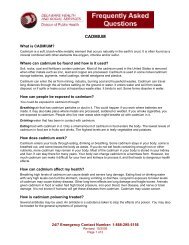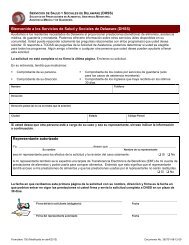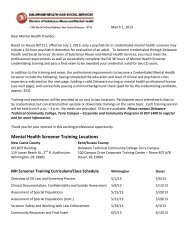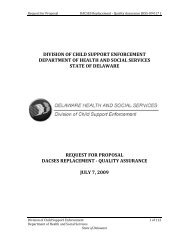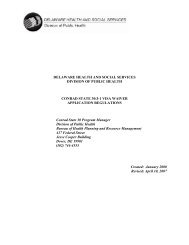TURPENTINE - Delaware Health and Social Services
TURPENTINE - Delaware Health and Social Services
TURPENTINE - Delaware Health and Social Services
You also want an ePaper? Increase the reach of your titles
YUMPU automatically turns print PDFs into web optimized ePapers that Google loves.
<strong>TURPENTINE</strong><br />
What is <strong>TURPENTINE</strong>?<br />
Turpentine is a yellow-colored, sticky liquid that comes from pine gum or pine wood. Turpentine turns into a<br />
vapor very easily, <strong>and</strong> it can catch fire. Oil of turpentine is a colorless liquid with a very strong smell. Other<br />
names for turpentine are gum spirits, turps, gum thus, D.D. turpentine, wood turpentine, oil of turpentine,<br />
rectified turpentine oil, spirits of turpentine, sulfate wood turpentine, sulfate turpentine, gum turpentine, <strong>and</strong><br />
steam-distilled turpentine.<br />
Where can turpentine be found <strong>and</strong> how is it used?<br />
In the past, turpentine was the most widely used paint <strong>and</strong> varnish thinner. It was also used in printing, hair<br />
products <strong>and</strong> medicines. It is still used in some paints <strong>and</strong> coatings. Today, less costly products have replaced<br />
the use of turpentine in paints. Now, the major use of turpentine is as a raw material for the chemical industry.<br />
It is also used for spray painting <strong>and</strong> pottery, ceramic coatings, artist’s paints <strong>and</strong> naval paints. Turpentine is<br />
sometimes found in shoe <strong>and</strong> furniture polishes. It is also used as a metal cleaner.<br />
Compounds extracted from turpentine can be used for tires, plastics, adhesives, flavors, fragrances, makeup,<br />
paints <strong>and</strong> medicine.<br />
How can people be exposed to turpentine?<br />
People who work in pulp or paper factories may be exposed to turpentine. Exposure at work can also occur at<br />
places that make flavorings, fragrances, coatings, metal cleaners or solvents. At home, you can be exposed<br />
through food, personal care products, household products <strong>and</strong> medicine. Pine forests are sources of natural,<br />
low level exposure to turpentine since trees release terpenes into the air.<br />
You could be exposed to turpentine through:<br />
Breathing vapors at work or at home, such as when painting.<br />
Drinking turpentine in medicine. Accidental drinking of turpentine is unlikely.<br />
Touching paint thinners or other products containing turpentine.<br />
Eye Contact by splashing turpentine in the eyes.<br />
How does turpentine work?<br />
Turpentine is easily taken into the intestines <strong>and</strong> the lungs. Some turpentine leaves the body when air is<br />
breathed out. The rest leaves the body in urine. It irritates the stomach <strong>and</strong> intestines <strong>and</strong> affects the nervous<br />
system.<br />
How can turpentine affect my health?<br />
Turpentine is poisonous if swallowed. Children <strong>and</strong> adults can die from drinking turpentine. Fortunately,<br />
turpentine causes taste <strong>and</strong> odor problems before reaching toxic levels in humans.<br />
Turpentine is thought to be only mildly toxic when used according to manufacturers’ recommendations. It can<br />
pass through the skin. Some people develop an allergy to turpentine when exposed to it for a long time.<br />
Turpentine exposure causes eye irritation, headache, dizziness <strong>and</strong> vomiting. Breathing or swallowing also<br />
causes kidney <strong>and</strong> bladder irritation.<br />
How is turpentine poisoning treated?<br />
There is no treatment for turpentine poisoning. A doctor will treat the symptoms. Medicine may be given if<br />
seizures occur. Pumping the stomach is only done if another poison has also been swallowed with the<br />
turpentine.<br />
24/7 Emergency Contact Number: 1-888-295-5156<br />
Revised: 01/2010<br />
Page 1 of 2
What should I do if exposed to turpentine?<br />
If turpentine gets in your eyes, flush the eyes right away. Use large amounts of water for at least 15<br />
minutes. Lift the lower <strong>and</strong> upper lids from time to time. Get medical help.<br />
If you touch turpentine, wash with soap <strong>and</strong> water. If irritation does not stop, or if a large area of skin is<br />
affected, get medical help.<br />
If you breathe turpentine, go to an area of fresh air. Get medical help. If it is hard to breathe, try to get<br />
oxygen. Stay warm <strong>and</strong> quiet until help arrives.<br />
If you swallow turpentine, drink several glasses of water. Do not throw up. Get medical help right away.<br />
Stay warm <strong>and</strong> quiet until help arrives.<br />
What factors limit use or exposure to turpentine?<br />
When working with turpentine, have a source of fresh air <strong>and</strong> a ventilation system. If this cannot be done,<br />
workers should wear a respirator. Wear protective work clothing. Wash well after exposure. Wash again at the<br />
end of the work shift.<br />
Is there a medical test to show whether I’ve been exposed to turpentine?<br />
There is no medical test for turpentine poisoning.<br />
Technical information for turpentine<br />
CAS Number: 8006-64-2<br />
Chemical Formula: C10H16<br />
Carcinogenicity (EPA): Turpentine has not been evaluated for carcinogenicity.<br />
MCL (Drinking Water): There is no MCL for turpentine.<br />
OSHA St<strong>and</strong>ards: 560 milligrams per cubic meter of air (100 parts per million).<br />
NIOSH St<strong>and</strong>ards: 560 milligrams per cubic meter of air (100 parts per million). IDLH 800 ppm (imminent<br />
danger to life <strong>and</strong> health).<br />
ACGIH: 20 ppm<br />
References <strong>and</strong> Sources<br />
American Conference of Governmental Industrial Hygienists (ACGIH). 2003. Guide to Occupational Exposure<br />
Values. Cincinnati, OH.<br />
Filipsson AF. 1996. Short term inhalation exposure to Turpentine: toxicokinetics <strong>and</strong> acute effects in men.<br />
Occup. Environ. Med.,1996 Feb;53(2):100-5.<br />
Irwin, R.J., M. VanMouwerik, L. Stevens, M.D. Seese, <strong>and</strong> W. Basham. 1997. Environmental Contaminants<br />
Encyclopedia. National Park Service, Water Resources Division, Fort Collins, Colorado.<br />
NIOSH Pocket Guide to Chemical Hazards. 2003. Atlanta, GA: U.S. Department of <strong>Health</strong> <strong>and</strong> Human<br />
<strong>Services</strong>.<br />
New Jersey Department of <strong>Health</strong> <strong>and</strong> Senior <strong>Services</strong>, Right to Know Hazardous Substances Fact Sheet,<br />
Turpentine, http://www.state.nj.us/health/eoh/rtkweb/1962.pdf - Accessed 1/5/10<br />
24/7 Emergency Contact Number: 1-888-295-5156<br />
Revised: 01/2010<br />
Page 2 of 2



